- Peter Tatchell congratulates himself on his journalistic integrity in his documentary on the Pope:
Early on, I decided to deviate from what might be expected of me. Instead of a ruthless Christopher Hitchens-style evisceration of Benedict XVI, I opted for a more subtle approach – and a degree of open-mindedness. I was ready to confound my own preconceptions. And I did, in some respects. I discovered that when he was plain Joseph Ratzinger ...
Although judging by Fr. Jeffrey Steele's review, Tatchell's performance was somewhat wanting:After watching the channel 4 programme tonight by Peter Tatchell all I could think about with my children who viewed it with me was that Tatchell became the best apologist for the Catholic Faith and our present Holy Father than I could have ever dreamed about. To see and hear my older children argue with the ignorant on the screen was priceless to me. It brought laughter from the children at how ridiculous and lacking in logic Tatchell is. My 13 year old daughter asked, 'how can you stand to watch any more of this rubbish?'
- The Catholic Herald provides a name-by-name introduction to "the seguito" -- the papal entourage of Vatican diplomats, secretaries, and curial officials accompanying the Pope (September 13, 2010). See also John Thavis's profile of "the mini-Vatican" (Catholic News Service. September 10, 2010).
- The BBC News profiles Jack Sullivan, who credits John Henry Newman with a "miracle cure" (September 12, 2010):
Orthopaedic surgeon Dr Robert Banco explained the back and leg pain was due to severe stenosis, or compression of the spinal cord and nerves.
The Boston doctor later told Vatican investigators it was "a miracle itself" his patient had been able to walk pain-free, let alone complete his religious studies, during the previous nine months.
He recommended a laminectomy to remove a part of the spinal bones that was causing the problem.
Although successfully performed in August 2001, this operation left Mr Sullivan in immense pain and he was warned he might not be able to walk properly for months.
Having taken an excruciating few minutes, with a nurse's help, to get his feet to the floor, he said he leant on his forearms and recited his prayer to Newman. ... [more]
- Now for a bit of history. Robert Barr (Associated Press) takes a look at the repression of Catholics in England centuries after the Reformation (September 12, 2010):
In the turmoil and persecution that followed the break between King Henry VIII and Rome, noble families such as the Stonors clung to their faith, "in spite of dungeon, fire and sword," as the Victorian hymn "Faith of our Fathers" put it.
On the other hand, the Guardian's Stephen Bates takes a look at significant strides in England's reception of Catholics in the past 50 years ("In the 1960s, when I was serving as an altar boy at mass, to be a Catholic was to be an outsider, a group outside the mainstream of British life, separate, slightly alien. ... How different today")."We're just stubborn, really," says Ralph Thomas Campion Stonor, the seventh Lord Camoys, a title bestowed on an ancestor for valor in the Battle of Agincourt in 1415.
Pope Benedict XVI will recall the years of persecution during his upcoming tour of Britain Sept. 16-19. He will visit Westminster Hall, the medieval chamber within the Houses of Parliament where the Catholic Thomas More was tried and convicted of treason in 1535. More refused to swear an oath accepting the annulment of King Henry's marriage, thus becoming one of the first of the legion of English Catholic martyrs.
The Stonor family's history mirrors the vicissitudes of Catholics, both noble and humble, who defied the law and risked death to preserve their faith through times of persecution until they regained full legal rights in the 19th century. ...
- Some more history -- Victor L. Simpson considers Pope Benedict's visit next week with the experience of his predecessor:
The Falklands war was in full swing and John Paul II was in London as the first pope ever to set foot on English soil.
The Catholic Herald reminds us, "One fact that hasn’t so far emerged from the first ever state visit by a Pope to Britain is that it follows two state visits to the Vatican by the Queen."Even as he snubbed Margaret Thatcher and prayed for peace in implicit criticism of Britain — whose troops were battling Catholic Argentines — the pontiff received a rapturous welcome and was described in glowing terms by the Archbishop of Canterbury.
His successor, Benedict XVI, can expect a far cooler — if not at times downright hostile — reception in his upcoming state visit.
It all underscores the contrasting public fortunes of the two leaders of the church. John Paul was an international superstar who could send a thrill even through non-Catholics and made many people forget how at odds he was with their personal views. Benedict seems to step into crisis and controversy at every turn when he ventures abroad on bridge-building missions. ... [more].
- In a speech to political and religious leaders in Westminster Hall, Pope Benedict is expected to defend the religious freedoms of Christians against encroaching secularism (The Telegraph September 12, 2010):
Senior Roman Catholic sources said his message would be seen as a criticism of the introduction of equality laws that have impinged on the freedom of religious groups, although he will not directly refer to government policy.
A number of Christians have lost their jobs or faced disciplinary action for practising their faith at work by wearing a crucifix or sharing their views on biblical teaching.
- Almost six in 10 Catholics say that their faith is not "generally valued" in British society, according to a poll commissioned by the BBC. However, the BBC reports, "70% of British Catholics polled expect the Pope's visit to help the Catholic Church in the UK." (September 12, 2010).
- "Seriously, don't these folks ever get tired of writing the same ol' stuff?" Carl Olson (Insight Scoop) asks the BBC. To save them the trouble, he generously provides a template (which can be tweaked here and there, of course, depending on your level of laziness and bias) to be used in writing about Pope Benedict XVI:
- Prominently mention that young Ratzinger served in the Nazi army. Don't provide any context—just let the association be made. After all, it's pretty hard to dig out of that hole!
- Immediately follow up with mention of the sex scandals. Imply that it is somehow the Pope's fault that certain priests are perverts and certain bishops are pathetic, or worse. Make it sound as though molestations and abuse are happening right now, rather than pointing out that vast majority took place over thirty years ago.
- Have plenty of quotes from those openly opposed to the Pope, as well as unnamed Catholics who question, doubt, or dislike the Pope and "his" positions. Anonymous priests, bishops, and nuns are best.
- Be certain to mention that as prefect of the CDF, Cardinal Ratzinger was the head of an office that is "the successor to the Inquisition." Let it hang out there, knowing it's a wonderfully negative (and misleading) buzzword. ...
- Midst the barrage of ridicule, a refreshing call to tolerance from The Telegraph:
In 1940, the British people fought not only to resist conquest but also to preserve their tolerant values. Today, this country permits and even celebrates many things of which the Catholic Church disapproves. But it should be stressed that this Pope, perhaps more than any other, is an admirer of British democracy. As a devotee of Cardinal Newman who speaks our language fluently, he appreciates our tradition of civilised discourse with people whose views we do not share.
For the Catholic Herald, the moment has come for English Catholics:In recent months, that tradition has been threatened by the anti-religious rhetoric of "defenders of the Enlightenment", who display an intellectual intolerance almost worthy of the Inquisition. That is a shame. By all means, let critics challenge the Pope's teachings while he is here. But this four-day visit is not an invitation to drown out the voice of the leader of a billion Christians with sneering and mockery. Visitors to these shores as well as British citizens have the right of free speech. Our distinguished guest must be allowed to exercise it.
The reception that Pope Benedict receives as he drives through our streets will tell us much about our society. If the faithful fill the streets and greet the Pontiff with applause and cries of support then the watching world will see that the faith of those who gave up their lives hundreds of years ago is alive and well in Britain. It is easy to fall into the trap of blaming others for the difficulties of the Church. But we will only have ourselves to blame if the Popemobile speeds through thin crowds next week.
We are confident that this will not be the case. We believe that, despite all the mishaps and difficulties along the way, Britain’s Catholics will rise to the occasion of the papal visit and give Benedict XVI the warm welcome he deserves.
- Zenit news provides further detail on the Scottish Tartan designed to commemorate the papal visit (September 13, 2010):
As with every tartan, colors will play a symbolic role in the St. Ninian plaid dedicated to Benedict XVI.
Newsome explained: "The white line on blue field draws upon Scotland's national colors while the green reflects the lichens growing on the stones of Whithorn in Galloway. It was there that St. Ninian first brought the Gospel of Jesus Christ to Scottish shores over 1,600 years ago.
"The white lines are also accompanied by a pair of red lines, reflecting the colors of Cardinal Newman's [who will be beatified by the Pope] crest. And finally, the thin yellow lines in the tartan, together with the white, reflect the colors of the Vatican."
"In terms of the weaving, each white line on the green contains exactly eight threads, one for each Catholic diocese in Scotland," he continued. "There are 452 threads in the design from pivot to pivot, representing the number of Catholic parishes."
In Brief
- People hoping to see the Pope leaving the UK at the end of his four-day visit have been urged not to go to Birmingham Airport (BBC September 13, 2010).
- Storm warning! -- The Daily Record predicts that Scotland will be flooded with tacky papal visit merchandise this week - including bizarre Pope-on-a-rope souvenirs. (Did we mention the papal trucker caps?)
- Reuters provides some interesting historical facts and statistics about Catholics in England.

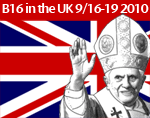
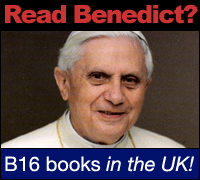
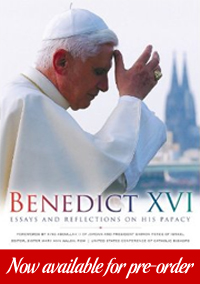
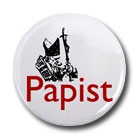

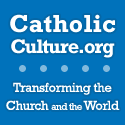
No comments:
Post a Comment